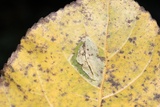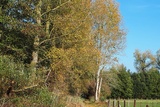Phyllonorycter populifoliella (Treitschke, 1833) Species
Last modified: Dec. 10, 2025, 5:48 p.m.
A rare species in Belgium, at first only known from some old records in the Sonian Forest (BR). During the last decennia, the species seems to expand its area northwards. It is now found widespread in Belgium, but still always rarely.
Details
- Classification
- Family: Gracillariidae > Subfamily: Lithocolletinae > Genus: Phyllonorycter > Species: Phyllonorycter populifoliella
- Vernacular names
- Grijze populierenvouwmot (NL), Pappel-Faltenminiermotte (DE)
- First mention in Belgium
- De Fré Ch. 1858. Catalogue des Microlépidoptères de la Belgique. — Annales de la Société entomologique belge 2: 45–162. On page 158. view page
- Status
-
Native
Distribution
Imago
Head grey, mixed with some brown hairs; forewing ground colour greyish brown; white pattern most of the time rather indistinct, three to four costal and three dorsal striae; the entire forewing mottled with disparsed brown-tipped scales.
Museum specimens
No pictures yet!Specimens in nature
No pictures yet!Mine
An oval tentiform mine on the underside of a leaf, most of the time between two secondary veins, and mainly situated near the basis of the leaf. No distinct longitudinal central fold, but some faint folds close to each other. The upper side of the mine turns yellow, at first with a green island in the centre, but in the last stage completely yellowish. The dark frass is concentrated in a corner of the mine.
See also gracillariidae.net and bladmineerders.be.
Cocoon/pupa
A white, circular cocoon.
Bionomics
Pupation inside the mine. The species hibernates in the pupal stage, in the cocoon within the fallen leaf between leaf litter on the ground. After the emergence of the adult, the pupal skin protrudes from the mine.
Flight periods
Two generations a year in April–May and August–September.
Observed on
- Host plant (species):
- Populus nigra, Populus × canadensis, Populus deltoides and Populus nigra var. italica
- Host plant (genera):
- Populus
The species is monophagous on Populus, with a preference for Populus nigra, but it has also been recorded on Populus x canadensis, P. deltoides and P. nigra var. italica.
Habitat
Forests, road sides, parks.




